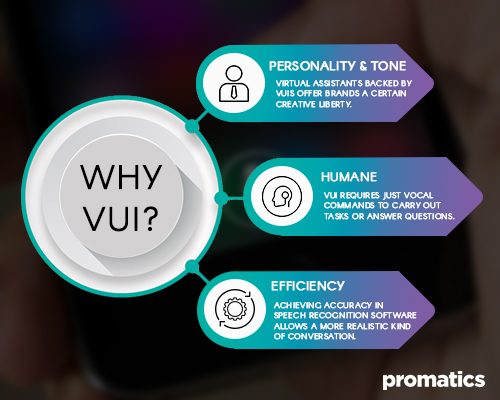What is Voice User Interface (VUI): All you need to know
The user interface (UI) is the mechanism that allows us to interact with machines. VUI or Voice User Interface uses speech recognition technology to facilitate interaction between user and technology. Largely hands-free, VUI allows interactions that are more convenient than any other form of user interface. VUI is a user-facing interface, so the focus here remains on interaction design and the voice application system being used. Featuring vivid conveniences pair with the power of AI, VUI can be your personal assistant which understands your current needs as well as predicts your future needs. VUI are gaining steep popularity among users and it would be beneficial if young developers understand all the potential pitfalls and positive opportunities that VUIs bring along:
Why VUI?
Adding VUI to your UX design allows a user the privilege of voice interaction with existing graphical interfaces making it more convenient for use. There is a certain X-factor that has popularised VUIs that other UIs evidently lack. Here is a list of things that give VUIs their edge:
Personality and Tone
Virtual assistants backed by VUIs offer brands a certain creative liberty to lace themselves with a personality and tone. This certainly can be more engaging for a user than the usual non-personified experience that other UIs offer. A personable tone also helps forgo occasional lapses in command reception or understanding.
Efficiency
VUI requires just vocal commands to carry out tasks or answer questions. It’s simple to use, efficient and adds splendid convenience to daily routines that can otherwise be taxing.
Humane
Achieving accuracy in speech recognition software allows a more realistic, say ‘human’ kind of conversation with the device which is far more indulgent for a user than robotic interactions.
Limitations of VUI
A VUI gone wrong can be extremely frustrating and can lead to a downfall of brands that associate themselves with it.
A.) Unrealistic User Expectation
Most of the times users are unsure of what they can expect from voice interaction. They have an inherent notion where they relate voice with communication and other people rather than relating it to technology. Hence, with VUIs they except flawless fluency of knowledge and thought along with a human conversational tone which is slightly too much to ask for when we are dealing with machines.
B.) Language Processing
No matter how advanced, a VUI with an inbuilt, natural and complex understanding of human communication is still a far cry from reality. Considerations like regional accents, slangs, conversational nuances, satire and sarcasm need to be made when it comes to human interactions with VUIs.
C.) Visual Feedback
A newbie user of VUIs ends up frustrated more often than in the absence of visual clues as to if he is being listened to or not or if his instructions are being adhered to. However, as a developer you can only create a certain number of visual affordances to a VUI, to help a user gain clear indications of what the interface can do or what are the options.
D.) Discovery and Retention
Being a fairly new offering in the world of UIs, the majority of users are clueless about the myriad things they can use VUIs for. Here, there is a need for developers to educate the users about what all options they can explore with VUIs. Working on ‘humanizing’ the whole VUI mechanism can also shoot up the retention rate in long-term.
How to Design a User’s Favorite VUI?
To develop a VUI experience that is unparalleled in terms of usage, brands and companies need to dig deep into what do their clients want from a virtual assistant. For example, a novel VUI user often finds himself clueless when it comes to voice command contact with technology, a developer must guide the user to talk to a VUI. Users hope that using a VUI will be like communicating to an actual human rather than an interaction with technology. The bottom line is that you as a developer need to understand the fundamentals of voice interaction. With increased sophistication and reasonably priced availability, the popularity of VUIs is soaring higher. Here are some guidelines on how to develop a great voice-driven user interface:
I.) Need for More than a Pre-programmed Script
Very often developers of VUI systems are made to adapt the rules of communication in order to accommodate the limitations of the device. This leads to user interaction with these devices pretty difficult. The nature of casual human communication is such that there are myriad possible answers to a query. This often lands virtual assistants in an uncomfortable loop.
The need of the hour is to develop an interface that can develop an insight into the context, tone, attitude and voice of the commander to present better results and options. We need a technology that makes use of historical data and the observation of previous patterns of behaviour of the user to better understand what they are trying to convey. Just a pre-programmed script.
II.) Educate Users about The Conveniences of VUIs
While a GUI can display to its users what options they can choose from, a VUI lacks the display option. New users base their conversations on heightened expectations from VUIs and often tend to start out asking for something that doesn’t make much sense to the system. Insufficient responses from the system in these cases lead to disappointment. A developer must provide the user with the options for interaction.
III.) Guide A User Through The Experience
Users using GUIs are able to see when they enter a new section or interface at all times, this knowledge is absent in the case of VUIs. In the case of VUIs, users need be told what functionality they are using, to avoid confusion about where they are. There are chances that they might activate a functionality by mistake. It’s best to guide a VUI user with voice command and plausible options at all steps.
IV.) Keep Prompts As Brief As Possible to Avoid Confusion
Developers need to understand the fact that speech is linear and vocal content is time-based. Users cannot skim through spoken content repeatedly like visual content. Users of VUIs are required to make quick decisions in response to questions they are subjected to with time passing. Therefore, developers of VUIs must ensure that the prompts they design should be short and concise, while still being clear enough for users. It’s best to present information in consumable pieces that can be retained when heard. Push info that is absolutely required in order to keep the interaction afloat.
V.) Limit the Number of Questions You Ask
Incorporate smart assumptions into your VUI wherever possible. Subjecting a user to non-essential questions are a huge thumbs down when it comes to user experience. It is best if the VUI is developed to make educated guesses when appropriate with an option of easily going back.
VI.) Don’t Go Overboard with Confirmations
Make sure you avoid dialogues that create too many confirmations. However, it is essential to confirm the actions of high consequence, like those that are publicly visible, that affect another person or where money is involved.
VII.) Ensure that the content on the VUI is for the Ear, not the Eye
The distinguishing feature about prompts written for voice-forward experiences is that they will be heard and not read. Thus, it is crucial to creating content that is suitable for spoken conversation. Additionally, ensure that you don’t use technical jargon that the user won’t understand or that does not sound organic. Use SSML tags to modify the prosody or add emphasis to your text. For instance, you can use the <prosody> tag to change the volume, pitch, and rate of the speech. Use the <phoneme> SSML tag to customize the pronunciation using the supported phonemes or add phonemic/phonetic pronunciation for the text.
VIII.) Offer an easy way out if the user ever gets stuck
Sometimes VUI can misunderstand what the user said and continue with the wrong information. In such cases where the user is stuck in the interaction, developers must ensure that they offer an easy way out of them. As a VUI designer, always design for the scenario where the assistant doesn’t understand the commands.
IX.) Use UX Analytics for Voice Apps
Developers need to track how the app is being used with the help of analytics soon after launching it. You can integrate a service like engagement metrics such as sessions per user or messages per session, languages used, behaviour flows, messages, intents, and utterances. This kind of user research helps a business in understanding the needs, behaviours and motivations of the user through observation and feedback. Creating a customer journey map can help user experience, as researchers identify the needs of users at the various stages of engagement. It can also educate them about how and where voice can be a method of interaction.
Conclusion
Combining VUI with GUI helps to streamline the navigation process on the whole. A successful VUI designer is someone who develops the navigation experience in such a that it assists the user at every step about how and what they can do at every step. In a quest to design a VUI that meets the expectation of modern consumers, developers must ensure that users are guided about how to express what they want in a way that the system can understand. Voice user interaction may pose more of a challenge than GUIs and businesses can use the assistance of a mobile development professional in nailing a seamless voice-geared experience in an app.
VUIs are here for the long run. We at Promatics Technologies, indulge in extensive user research to understand the needs of the business and to decide whether or not voice will improve the UX.
Still have your concerns?
Your concerns are legit, and we know how to deal with them. Hook us up for a discussion, no strings attached, and we will show how we can add value to your operations!



